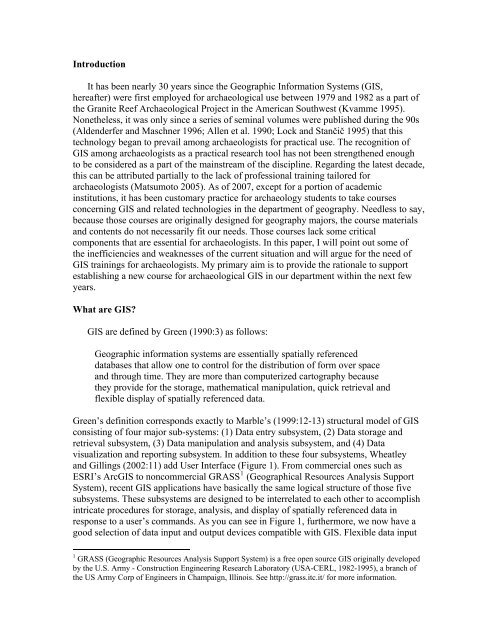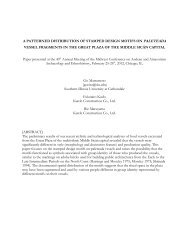GIS Trainings for Archaeologists
GIS Trainings for Archaeologists
GIS Trainings for Archaeologists
You also want an ePaper? Increase the reach of your titles
YUMPU automatically turns print PDFs into web optimized ePapers that Google loves.
Introduction<br />
It has been nearly 30 years since the Geographic In<strong>for</strong>mation Systems (<strong>GIS</strong>,<br />
hereafter) were first employed <strong>for</strong> archaeological use between 1979 and 1982 as a part of<br />
the Granite Reef Archaeological Project in the American Southwest (Kvamme 1995).<br />
Nonetheless, it was only since a series of seminal volumes were published during the 90s<br />
(Aldenderfer and Maschner 1996; Allen et al. 1990; Lock and Stančič 1995) that this<br />
technology began to prevail among archaeologists <strong>for</strong> practical use. The recognition of<br />
<strong>GIS</strong> among archaeologists as a practical research tool has not been strengthened enough<br />
to be considered as a part of the mainstream of the discipline. Regarding the latest decade,<br />
this can be attributed partially to the lack of professional training tailored <strong>for</strong><br />
archaeologists (Matsumoto 2005). As of 2007, except <strong>for</strong> a portion of academic<br />
institutions, it has been customary practice <strong>for</strong> archaeology students to take courses<br />
concerning <strong>GIS</strong> and related technologies in the department of geography. Needless to say,<br />
because those courses are originally designed <strong>for</strong> geography majors, the course materials<br />
and contents do not necessarily fit our needs. Those courses lack some critical<br />
components that are essential <strong>for</strong> archaeologists. In this paper, I will point out some of<br />
the inefficiencies and weaknesses of the current situation and will argue <strong>for</strong> the need of<br />
<strong>GIS</strong> trainings <strong>for</strong> archaeologists. My primary aim is to provide the rationale to support<br />
establishing a new course <strong>for</strong> archaeological <strong>GIS</strong> in our department within the next few<br />
years.<br />
What are <strong>GIS</strong>?<br />
<strong>GIS</strong> are defined by Green (1990:3) as follows:<br />
Geographic in<strong>for</strong>mation systems are essentially spatially referenced<br />
databases that allow one to control <strong>for</strong> the distribution of <strong>for</strong>m over space<br />
and through time. They are more than computerized cartography because<br />
they provide <strong>for</strong> the storage, mathematical manipulation, quick retrieval and<br />
flexible display of spatially referenced data.<br />
Green’s definition corresponds exactly to Marble’s (1999:12-13) structural model of <strong>GIS</strong><br />
consisting of four major sub-systems: (1) Data entry subsystem, (2) Data storage and<br />
retrieval subsystem, (3) Data manipulation and analysis subsystem, and (4) Data<br />
visualization and reporting subsystem. In addition to these four subsystems, Wheatley<br />
and Gillings (2002:11) add User Interface (Figure 1). From commercial ones such as<br />
ESRI’s Arc<strong>GIS</strong> to noncommercial GRASS 1 (Geographical Resources Analysis Support<br />
System), recent <strong>GIS</strong> applications have basically the same logical structure of those five<br />
subsystems. These subsystems are designed to be interrelated to each other to accomplish<br />
intricate procedures <strong>for</strong> storage, analysis, and display of spatially referenced data in<br />
response to a user’s commands. As you can see in Figure 1, furthermore, we now have a<br />
good selection of data input and output devices compatible with <strong>GIS</strong>. Flexible data input<br />
1 GRASS (Geographic Resources Analysis Support System) is a free open source <strong>GIS</strong> originally developed<br />
by the U.S. Army - Construction Engineering Research Laboratory (USA-CERL, 1982-1995), a branch of<br />
the US Army Corp of Engineers in Champaign, Illinois. See http://grass.itc.it/ <strong>for</strong> more in<strong>for</strong>mation.






